
Casa Blanca reveals centuries of history
SAN JUAN, P.R. — Aida Maria de Ayala de Sevilla begins her tours with a caveat: “my tour is not a tour. It is a confession.”
A confession of four walls and nearly 500 years of history and cultural identity.
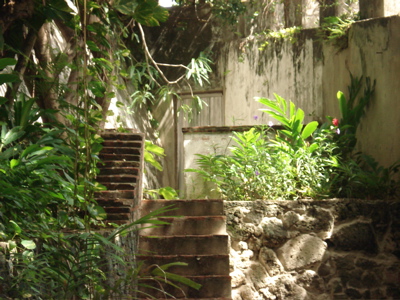 |
The terraced garden that surrounds Casa Blanca provides a peaceful afternoon respite, much like it did in the days of Ponce de Leon II (Photo by Danielle McNally).
|
De Sevilla is telling the story of Casa Blanca, once home to the descendents of Ponce de Leon, and a piece of both San Juan’s and Puerto Rico’s rich cultural heritage. On a visit to Old San Juan, Casa Blanca is a must-stop on any history-buff’s list.
Built in 1523 as both a residence and a fort, Casa Blanca was the first building protecting the people of Puerto Rico.
“Casa Blanca is to me the first building, the first organism of San Juan,” said de Sevilla.
Casa Blanca’s history is as rich and varied as that of the Puerto Rican people it has come to represent. From a Spanish fort to a familial residence, a military complex for first the Spanish then the Americans, and now a museum of 16th and 17th Century art and furnishing under the auspices of the Institute of Puerto Rican Culture, Casa Blanca’s purpose has changed with the fickle tides of imperialism and international relations.
Upon arrival at Casa Blanca, guests will personally hear de Sevilla’s retelling of Casa Blanca’s tale. De Sevilla gives only individual tours, welcoming one group at a time into what she jokingly calls “my house.”
De Sevilla has been an employee of the Institute of Puerto Rican Culture and the official museum guide at Casa Blanca for 27 years, and the connection she feels to the house as part of her heritage is palpable.
She tells the history of Casa Blanca as if narrating a stage drama, painting scenes in the minds-eye of her guests.
|
From the gardens of Casa Blanca, guests can observe the evolution of the house, from the castellated walls of the 16th century to the two-story addition put on in the 19th century (Photo by Danielle McNally).
|
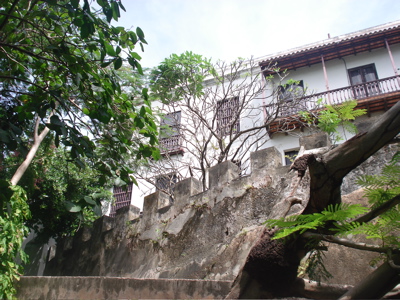 |
“Imagine…” she begins each new scene, and visitors are transported with de Sevilla back to a more romantic, simpler time.
Casa Blanca began as the home of Juan Ponce de Leon, the first governor under the Spanish King of Puerto Rico, and is best known in that role. However, Ponce de Leon never lived in nor even saw the house. He died in 1521, before the house was completed.
Construction of the house was actually overseen by Ponce de Leon’s son-in-law, García Troche. It was intended to be not just a family home, but also to serve as protection for the residents of Old San Juan, as the impressive forts of El Morro and San Cristóbal were not yet even conceived.
However the first house was made of wood and as de Sevilla puts it, “a wooden house? A wooden house in 1521? Forget that house.”
The original house was destroyed by a fire and a new house made of stone with battlements and a castellated wall was built in 1523.
The Spanish government quickly realized that Casa Blanca was too small to serve as a fortress for their burgeoning city and construction was begun on La Fortaleza, which still serves as the home of the Puerto Rican governor today.
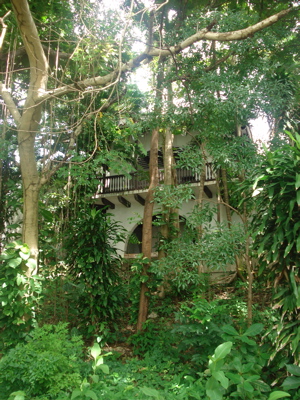 |
Casa Blanca was developed in a tropical setting, making it easy for guests to see why Ponce de Leon and his family would want to settle there (Photo by Danielle McNally). |
However, for the approximately 15-year span between the respective completions of Casa Blanca and then La Foraleza, Casa Blanca served as the seat of the head of the government in Puerto Rico.
For the next 250 years, Casa Blanca was home to the descendents of Juan Ponce de Leon. However it is not for this Ponce that the house is dedicated. It is for Ponce de Leon’s grandson, Juan Ponce de Leon II. He was the first illustrious Puerto Rican, and served as Acting Governor of Puerto Rico in 1579, making him the first natural-born Puerto Rican to hold such a title.
Guests visiting Casa Blanca today will see the house as it likely looked while the Ponce de Leon family called it home. Although the furniture is not original (most of it was destroyed when the Dutch seized and set fire to San Juan), Ricardo Alegria, the first curator of Casa Blanca as a museum, selected the best pieces from Spain to re-create an authentic look. He sought to illustrate the ambiance and style of that time period so that the house could serve the people of Puerto Rico as an exhibition of the accommodations and home life of the 16th and 17th centuries.
One piece of furniture that de Sevilla is very proud of and is an important stop on the tour is the dowry chest that sits in the foyer. This dowry chest is the oldest in Puerto Rico and is unique in that the owner needs three keys in order to open the chest and encounter the contents.
Why three keys? This became popular amongst prominent Puerto Ricans after the king ordered it so.
|
This fountain is just one example of the regal elements that can be found throughout Casa Blanca (Photo by Danielle McNally). |
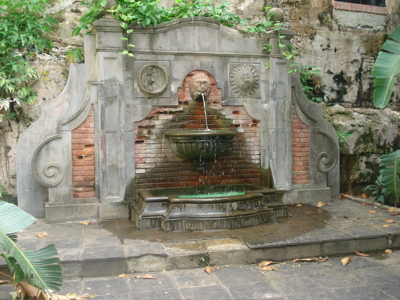 |
“The king said, ‘I don’t want one person controlling the key. Two?! They get friendly. It is better to be three,’” de Sevilla relates the story to tour-goers, witty jokes sprinkled throughout.
However it is not just the furnishings that are not part of the original house. After the Spanish government expropriated the house from the Ponce de Leon family, it was taken over by Spanish military engineers and many additions were made, including another two-story wing and the stables, which served as soldiers’ barracks.
Later, when Puerto Rico became a territory of the United States following the Spanish-American War, Casa Blanca became home to the commander of the US Army stationed in Puerto Rico.
“Oh jeez, it was very fancy then,” said de Sevilla.
“I have heard things that are not written in the paper,” de Sevilla said as she explains the interesting effects of these changes to her guests.
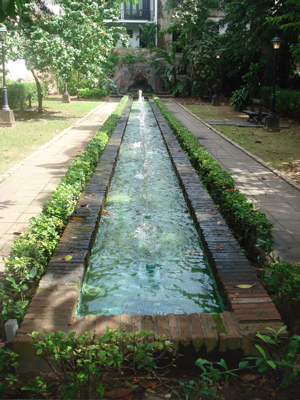 |
This fountain, one of many surrounding Casa Blanca, seems as though it might continue infinitely through the plush landscape of the garden (Photo by Danielle McNally). |
At the beginning of the tour, De Sevilla points out a watercolor painting given to the Puerto Ricans by the Dutch depicting the city as it looked in the 16th century. In the painting visitors can see Casa Blanca with its high, castellated wall.
However, upon touring the house, guests will see through the windows, that the castellated wall hits at floor level. Casa Blanca was built on a hill, and the stone walkway that guests use to arrive today, puts guests at the first floor of the two-story addition, meaning the original home is actually below them.
However, don’t plan on touring the original first floor. The military engineers, who are “not romantic,” as de Sevilla describes them, sealed off the original door. They even brought in modern furniture and left the garden in disrepair.
“The confession is now: what garden? It doesn’t exist,” said de Sevilla. The assumption of the house by the U.S. government in the 20th century, returned the garden to some of its original splendor, and de Sevilla now plays a game with her guests, encouraging them to try and find the original door during their tour of the garden.
Before allowing guests to amble amongst the lush tropical plants and peaceful flowing fountains of the grounds, de Sevilla makes one last confession for the house.
| The gardens surrounding Casa Blanca provide a perfect place for visitors to sit, relax (Photo by Danielle McNally). |
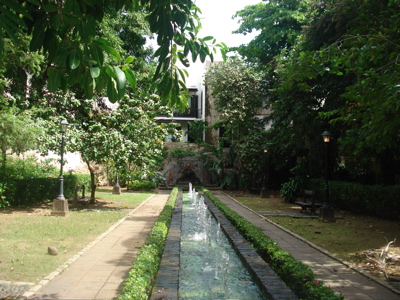 |
Underneath Ponce de Leon II’s office, a hatch in the floor, once hidden by furniture, has been discovered, and below lies a secret room.
Peering into the darkness, guests can make out a chest and a brick archway leading to someplace unknown. The secret basement appears dark and damp, like something out of Pirates of the Caribbean. De Sevilla is convinced that this archway leads to a secret tunnel that runs back to El Morro.
Whether or not secret tunnel-ways once used by Spanish military to escape attack really exist, it is the mysterious details such as this found all over Old San Juan that add to the romanticism and adventure of such a storied location.
If You Go
- Casa Blanca is located at: Calle San Sebastián #1, Viejo San Juan, only about a three minute walk from El Morro.
- Although the hours are listed as 9 a.m. to 4 p.m., Tuesday through Saturday, the museum is closed 12 to 1 p.m. for lunch. It is closed on Sundays and Mondays. Hours can be haphazard generally, so call ahead before you go: 787-725-1454.
- Admission is $3 for all.
- There are restroom facilities on the property for visitors. The museum itself is handicap accessible, but certain areas of the garden are not.
- Following your tour, take an easy walk down Calle San Sebastián, where numerous restaurants serve traditional Puerto Rican fare.

Comments are Closed